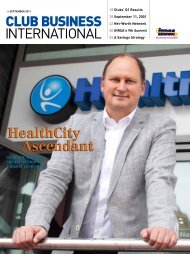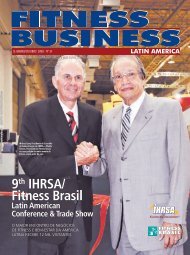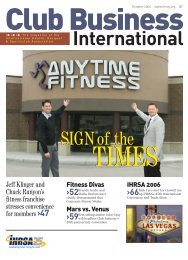Augie In Action! Augie In Action! - Ihrsa
Augie In Action! Augie In Action! - Ihrsa
Augie In Action! Augie In Action! - Ihrsa
Create successful ePaper yourself
Turn your PDF publications into a flip-book with our unique Google optimized e-Paper software.
How to Turn Attrition Around<br />
“ Whenever, over<br />
a 60-day period,<br />
a member’s usage<br />
drops by 50% or<br />
more, that member<br />
is in danger<br />
of quitting. ”<br />
74 Club Business <strong>In</strong>ternational | MARCH 2008 | www.ihrsa.org<br />
Clubs with strong member-to-member connections<br />
have higher retention than clubs with weak memberto-member<br />
connections. Multipurpose clubs have<br />
higher retention rates than fitness clubs (71.9% vs.<br />
69.1%, according to the 2007 edition of IHRSA’s<br />
Profiles of Success). Although IHRSA does not collect<br />
data on tennis-only clubs, we know, anecdotally,<br />
that tennis clubs have higher retention rates than<br />
multipurpose clubs.<br />
Anecdotally, we have also learned that country clubs have higher retention rates than<br />
commercial clubs of all types. These private clubs achieve this despite the fact that many of their<br />
properties, especially in the Midwest and Northeast, lie fallow from November 1 to May 1.<br />
This point underlines the importance of a fact that is seldom discussed: namely, that memberto-member<br />
connections, as distinguished from member-to-staff connections, are integral to every<br />
club with high retention. An argument can be made—and it is an argument with which I agree—<br />
that in terms of achieving high membership retention rates, member-to-member connections<br />
are much more important than member-to-staff connections. Therefore, the assumption that<br />
the retention issue can be resolved simply and exclusively by enhancing staff-to-member<br />
connections is, in my opinion, fundamentally flawed.<br />
I have visited many private clubs where the staff-to-member connections are no better or<br />
no worse than such connections at athletic or fitness facilities. Yet, year after year, these clubs<br />
achieve membership retention rates that are substantially higher than those of even the best<br />
performing athletic or fitness facilities. Several factors are at play here, including price<br />
and cachet, but it is the member-to-member connections and the social environment of these<br />
facilities that give them such a huge advantage with respect to membership retention.<br />
Members who use multiple services at a club have higher retention rates than members<br />
who only use one service. For example, the member who uses only the treadmill is<br />
more likely to leave than the member who uses the treadmill, the café, personal training<br />
services, and the spa.<br />
Getting members involved in multiple dimensions of a club is always advisable. This is<br />
another advantage of couple and family memberships because generally the spouses and the<br />
different members of a family are all involved in different activities at the club.<br />
It is also part of the rationale behind why club cafés—though they are often not profitable in<br />
themselves—can be an important asset with respect to membership retention. Such facilities<br />
not only expand members’ breadth of usage, but they also facilitate member-to-member and<br />
staff-to-member connections.<br />
Retention rates are higher for ‘group fitness’ members than for ‘machine members.’<br />
Every club has hundreds, and sometimes thousands, of “machine members,” i.e., members<br />
whose only interactions with their club are with the particular exercise machines on which<br />
they exercise. Such members tend to be deficient in both member-to-member connections<br />
and member-to-staff connections. Their only connection to the club is the connection that they<br />
have to the cold metal machines on which they perform their exercises.<br />
Machine members are, by definition, high-risk members.<br />
They belong, as it were, in every club’s “intensive care<br />
unit.” The loyalty of such members is paper-thin. For<br />
them, their club is no more than a place that stockpiles<br />
exercise machines.<br />
Participation in group activites correlates with<br />
higher retention. As might be anticipated from<br />
the previous discussion of machine members,<br />
members who are involved in group activities—
















